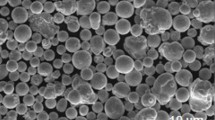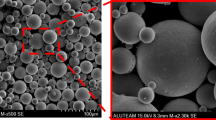Abstract
As a chip-free and high-efficiency three-dimensional forming technology, laser cladding has been successfully applied in the green manufacturing and remanufacturing of some high-end engineering parts/components. However, in most cases, cladding coatings need to be machined due to the poor surface finishing by sole laser cladding technique. The study aims to explore an effective way to replace the current machining process after laser cladding, which is supposed to be incapable of satisfying the various technical requirements of some high-demand engineering parts/components. With this purpose, three new surface strengthening processes, i.e. ultrasonic roller burnishing at ambient temperature (URB), ultrasonic roller burnishing at warm temperature (UWB), and UWB coupled with continuous heat treatment (UWB/HT), were proposed and comparatively explored. The contact stresses between the contact pairs in URB were calculated and analyzed in theory. A set of ultrasonic roller burnishing equipment was self-manufactured to perform the experiment. Comparing with the conventional process, the three new processes were evaluated mainly from aspects of surface finishing, the adhesion behavior and corrosion resistance of the finished surface. Summarily, ultrasonic warm burnishing coupled with continuous heat treatment (UWB/HT) is considered to have the greatest potential to achieve the effective machining after laser cladding with excellent surface finishing over the other two strategies, which is expected to further advance the application of laser cladding technique particularly in the fabrication of some high-demand products serving in harsh conditions.
Graphic abstract
















Similar content being viewed by others
References
Janicki D. Laser cladding of Inconel 625-based composite coatings reinforced by porous chromium carbide particles. Opt Laser Technol. 2017;94:6–14.
Chen D, et al. Direct digital manufacturing: definition, evolution, and sustainability implications. J Clean Prod. 2015;107:615–25.
Chen C, et al. A review on remanufacture of dies and moulds. J Clean Prod. 2014;64:13–23.
Murkute P, Pasebani S, Isgor OB. Production of corrosion-resistant 316L stainless steel clads on carbon steel using powder bed fusion-selective laser melting. J Mater Process Technol. 2019;273:116–243.
Tanigawa D, Abe N, Tsukamoto M, Hayashi Y, Yamazaki H, Tatsumi Y, Yoneyama M. The effect of particle size on the heat affected zone during laser cladding of Ni–Cr–Si–B alloy on C45 carbon steel. Opt Lasers Eng. 2018;101:23–7.
Li Z, et al. Microhardness and wear resistance of Al2O3-TiB2-TiC ceramic coatings on carbon steel fabricated by laser cladding. Ceram Int. 2019;45:115–21.
Walker TR, Bennett CJ, Lee TL, Clare AT. A validated analytical-numerical modelling strategy to predict residual stresses in single-track laser deposited IN718. Int J Mech Sci. 2019;151:609–21.
Xu M, Li J, Jiang J, Li B. Influence of powders and process parameters on bonding shear strength and micro hardness in laser cladding remanufacturing. Procedia CIRP. 2015;29:804–9.
Chen C, et al. Simplification and experimental investigation of geometrical surface smoothness model for multi-track laser cladding processes. J Manuf Process. 2018;36:621–8.
Sampedro J, et al. Laser cladding of TiC for better titanium components. Phys Procedia. 2011;12:313–22.
Ukar E, et al. Laser polishing parameter optimisation on selective laser sintered parts. Int J Mach Mach Mater. 2010;8(3/4):417–32.
Kaplan A, Groboth G. Process analysis of laser beam cladding. J Manuf Sci Eng. 2001;123:609–14.
Zhang P, Liu Z. Plastic deformation and critical condition for orthogonal machining two-layered materials with laser cladded Cr–Ni-based stainless steel onto AISI 1045. J Clean Prod. 2017;149:1033–44.
Böß V, et al. Repairing parts from nickel base material alloy by laser cladding and ball end milling. Prod Eng. 2016;10:433–41.
Zhang PR, Liu ZQ, Guo YB. Machinability for dry turning of laser cladded parts with conventional vs. wiper insert. J Manuf Process. 2017;28:494–9.
Chew Y, et al. Effects of laser cladding on fatigue performance of AISI 4340 steel in the as-clad and machine treated conditions. J Mater Process Technol. 2017;243:246–57.
Bozdana AT, Gindya NN, Li H. Deep cold rolling with ultrasonic vibrations—a new mechanical surface enhancement technique. Int J Mach Tool Manuf. 2005;45:713–8.
Badreddine J, Rouhaud E, Micoulaut M, Remy S. Simulation of shot dynamics for ultrasonic shot peening: effects of process parameters. Int J Mech Sci. 2014;82:178–90.
Ren NF, et al. High temperature mechanical properties and surface fatigue behavior improving of steel alloy via laser shock peening. Mater Des. 2014;53:452–6.
Hassani-Gangaraj SM, Carboni M, Guagliano M. Finite element approach toward an advanced understanding of deep rolling induced residual stresses, and an application to railway axles. Mater Des. 2015;83:689–703.
Teimouri R, Amini S, Bami AB. Evaluation of optimized surface properties and residual stress in ultrasonic assisted ball burnishing of AA6061-T6. Measurement. 2018;116:129–39.
Mo Y, et al. Improved plasticity and cold-rolling workability of Fe–65 wt% Si alloy by warm-rolling with gradually decreasing temperature. J Mater Sci Technol. 2016;32:477–84.
Spena PR, Firrao D. Thermomechanical warm forging of Ti–V, Ti–Nb, and Ti–B microalloyed medium carbon steels. Mater Sci Eng A. 2013;560:208–15.
Amanov A, et al. Strengthening of Ti-6Al-4V alloy by high temperature ultrasonic nanocrystal surface modification technique. Mater Lett. 2017;196:198–201.
Amanov A, Umarov R. The effects of ultrasonic nanocrystal surface modification temperature on the mechanical properties and fretting wear resistance of Inconel 690 alloy. Appl Surf Sci. 2018;441:515–29.
Shen X, et al. An investigation of stress condition in vibration-assisted burnishing. Int J Adv Manuf Technol. 2019;105(1–4):1189–207.
JohnsonK L. Contact mechanics. London: Cambridge University Press; 1985.
Siu KW, Ngan AHW, Jones IP. New insight on acoustoplasticity—ultrasonic irradiation enhances subgrain formation during deformation. Int J Plast. 2011;27:788–800.
Yang Z, et al. Porosity elimination and heat treatment of diode laser-clad homogeneous coating on cast aluminum-copper alloy. Surf Coat Technol. 2017;321:26–35.
Amanov A, et al. Fretting wear and friction reduction of CP titanium and Ti–6Al–4V alloy by ultrasonic nanocrystalline surface modification. Surf Coat Technol. 2012;207:135–42.
Su H, Shen X, et al. Surface characteristics and corrosion behavior of TC11 titanium alloy strengthened by ultrasonic roller burnishing at room and medium temperature. J Mater Res Technol. 2020;9(4):8172–85.
Nikitin I, Besel M. Residual stress relaxation of deep-rolled austenitic steel. Scr Mater. 2008;58:239–42.
Li HY, et al. Effects of compressive residual stress on short fatigue crack growth in a nickel-based superalloy. Int J Fatigue. 2018;108:53–61.
Amanov A. Wear resistance and adhesive failure of thermal spray ceramic coatings deposited onto graphite in response to ultrasonic nanocrystal surface modification technique. Appl Surf Sci. 2019;477:184–97.
Ritchie RO. The conflicts between strength and toughness. Nat Mater. 2011;10:817–22.
Peyre P, et al. Surface modifications induced in 316L steel by laser peening and shot-peening. Influence on pitting corrosion resistance. Mater Sci Eng A. 2000;280(2):294–302.
Pradhan D, et al. Effect of surface roughness on corrosion behavior of the superalloy in718 in simulated marine environment. J Alloys Compd. 2018;740:250–63.
Zhang H. TIG cladding in-situ nano vanadium carbide reinforced Fe-based ultra-fine grain layers under water cooling condition. Surf Coat Technol. 2018;2018(352):222–30.
Acknowledgments
This study was supported by the National Natural Science Foundation of China [Grand numbers 51775285, 51475275]; Key Research and Development Program of Shandong Province of China [Grand number 2019GGX104093]; Project for the Innovation Team of Universities and Institutes in Jinan [Grand number 2018GXRC005].
Author information
Authors and Affiliations
Corresponding author
Ethics declarations
Conflict of interest
On behalf of all authors, the corresponding author states that there is no conflict of interest.
Additional information
Publisher's Note
Springer Nature remains neutral with regard to jurisdictional claims in published maps and institutional affiliations.
Supplementary Information
Below is the link to the electronic supplementary material.
Supplementary file1 (294746 AVI)
Supplementary file2 (294746 AVI)
Rights and permissions
About this article
Cite this article
Shen, X., Su, H., Wang, J. et al. New approach towards the machining process after laser cladding. Archiv.Civ.Mech.Eng 21, 8 (2021). https://doi.org/10.1007/s43452-020-00153-8
Received:
Revised:
Accepted:
Published:
DOI: https://doi.org/10.1007/s43452-020-00153-8




